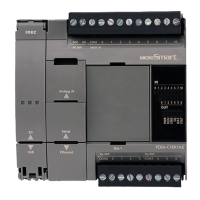FC6A S
ERIES
MICROS
MART
L
ADDER
P
ROGRAMMING
M
ANUAL
FC9Y-B1726 5-1
5: MOVE INSTRUCTIONS
Introduction
Data can be moved using the MOV (move), MOVN (move not), IMOV (indirect move), or IMOVN (indirect move not) instruction.
The moved data is 16- or 32-bit data, and the repeat operation can also be used to increase the quantity of data moved. In the
MOV or MOVN instruction, the source and destination device are designated by S1 and D1 directly. In the IMOV or IMOVN
instruction, the source and destination device are determined by the offset values designated by S2 and D2 added to source device
S1 and destination device D1.
The BMOV (block move) instruction is useful to move consecutive blocks of timer, counter, and data register values.
The IBMV (indirect bit move) and IBMVN (indirect bit move not) instructions move one bit of data from a source device to a
destination device. Both devices are determined by adding an offset to the device.
NSET (N data set) and NRS (N data repeat set) instructions can be used to set values to a group of devices. The XCHG (exchange)
instruction is used to swap word or double-word data between two devices. The current timer or counter values can be changed
using the TCCST (timer/counter current value store) instruction.
Since the move instructions are executed in each scan while input is on, a pulse input from a SOTU or SOTD instruction should be
used.
MOV (Move)
Valid Devices
For valid device address ranges, see "Device Addresses" on page 2-1.
Special internal relays cannot be designated as D1.
When T (timer) or C (counter) is used as S1, the timer/counter current value (TC or CC) is displayed. When T (timer) or C (counter) is used as D1,
the data is written in as a preset value (TP or CP) which can be 0 through 65,535.
When F (float) data is selected, only data register and constant can be designated as S1, and only data register can be designated as D1.
When F (float) data is selected and S1 does not comply with the normal floating-point format, a user program execution error will result, turning on
special internal relay M8004 and ERR LED on the FC6A Series MICROSmart. For user program execution errors, see "User Program Execution Errors"
on page 3-10.
P (index register) can be used only when the data type is L (long).
Valid Data Types
S1 → D1
When input is on, 16- or 32-bit data from device assigned by S1 is moved to device
assigned by D1.
REP
**
S1(R)
*****
D1(R)
*****
MOV(*)
Device Function I Q M R T C D P Constant Repeat
S1 (Source 1) First device address to move XXXXXXXX X 1-99
D1 (Destination 1) First device address to move to — X X X X X X — 1-99
W (word) X When a bit device such as I (input), Q (output), M (internal relay), or R (shift register) is assigned as the source
or destination, 16 points (word or integer data) or 32 points (double-word or long data) are used. When repeat is
assigned for a bit device, the quantity of device bits increases in 16- or 32-point increments.
When a word device such as T (timer), C (counter), or D (data register) is assigned as the source or destination,
1 point (word or integer data) or 2 points (double-word, long, or float data) are used. When repeat is assigned for
a word device, the quantity of device words increases in 1- or 2-point increments.
I (integer) X
D (double word) X
L(long) X
F(float) X

